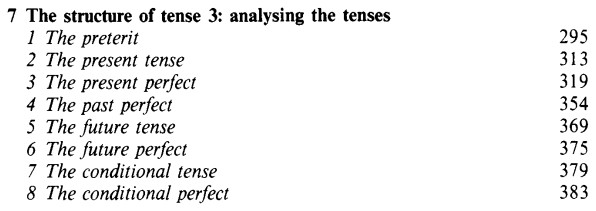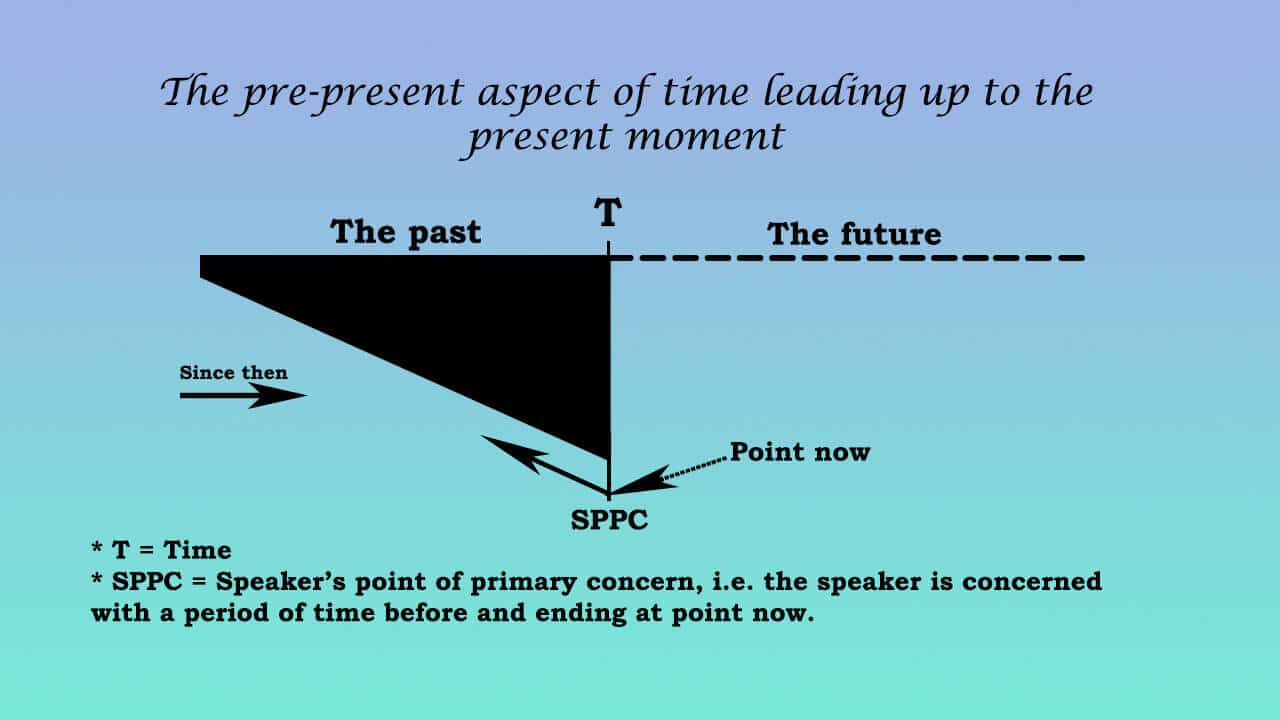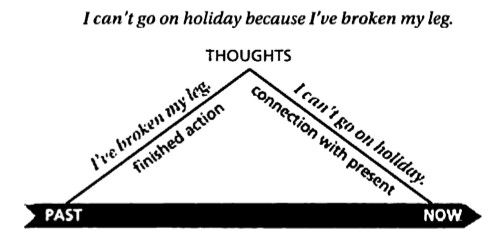The Present Perfect Simple Tense – Everything you need to know
Many educators and students claim that the present perfect simple tense is one of the major stumbling blocks to a smooth transition from intermediate level to advanced level.
There are many factors which lead to the phenomenon known as 'The Intermediate Plateau' - a phase of language learning which is largely associated with disorientation. Certainly, the tendency among intermediate-level learners of English to hesitate in their speech due to their inability to decide whether to use either the past simple or present perfect is perfectly indicative of such a state of confusion. It's impossible to overcome the Intermediate Plateau if you show signs of indecisiveness in the heat of conversation.
In his book, Tense in English: Its structure and use in discourse, Renaat Declerck devotes some 36 pages to analysing the present perfect tense. Conversely, he only allocates six pages to the present (simple) tense.

There’s only one conclusion to draw from the contents page in Declerck’s book. The present perfect is a hot topic among scholars of the English language. Who could argue against the present perfect being the hottest of all subject matters in the field of English language learning?
This post is intended to be a definitive guide to the more theoretical aspects of the present perfect simple tense.
How do you form the present perfect simple tense?
We form the present perfect with has (‘s) or have (‘ve) followed by the main verb in a past participle form.
These participles may be regular (e.g. stayed) or irregular (e.g. taken).

Source: Parrott (2000), p.236 (adapted)
What does the present perfect tense describe?
I’ll discuss the main uses of the present perfect simple tense in the next section. However, let me briefly summarise what authors of standard reference grammars tend to emphasise with regard to this tense:
- The present perfect is predominantly a present tense in a grammatical sense, even though it may describe a connection to the past;
- It refers to a point in the past "with current relevance" to the moment of speaking (Quirk et al. 1985, p. 190) ;
- The present perfect is collocationally congruent with indefinite time adverbs, such as recently, lately, already etc. However, the tense is also incompatible with adverbs of finished time (e.g. yesterday, in 1982, last weekend).
The idea that we should locate situations in an independent pre-present sector
In contrast to point 1 above, Declerck (1991, p.19) states that we should locate situations in an independent pre-present sector. In other words, we shouldn't categorise the present perfect as either a past tense or a present tense.
The pre-present may begin at any time in the past, no matter how long ago (Close, 1992, p.62). Still, the speaker generally devotes more attention to that part of the period which is nearest the present, i.e. the recent past, hence the darker shading in this diagram:

Source: Close (1992), p.68 (Fig.22) (Adapted)
With reference to the diagram above, the T arrow remains pointing vertically downwards. The SPPC arrow points backwards into pre-present time. This means that the speaker is referring to a period of time before and ending at Point now. The speaker is not concerned with a specified time before now. If that were the case, SPPC would be behind T, not level with it.
Hence, the beginning of the pre-present period may or may not be mentioned. Nevertheless, the word since often marks the start of the pre-present sector: We’ve been here since Friday
The elusive nature of the present perfect
To round off this section, it seems fair to mention the “elusive character” of the present perfect (Werner, 2014, p.48).
Dig a little deeper and you will find authors who stress the anterior traits of the present perfect. For instance, Biber et al. (1999, p.460) take such a stance, mentioning the tense’s continuative properties along the way.
Huddleston and Pullum categorise the present perfect as a “secondary past tense” (Huddleston and Pullum, 2002, p.116).
Contrary to the views above, Quirk et al. (1985, p.192) describe the general meaning of the present perfect as "current relevance".
The present perfect is an elusive category as it exhibits characteristics that are representative of both tense and aspect. For your information, tense refers to how time is encoded, something which is often based on morphological form (e.g. take, takes, took). Conversely, aspect is a property of a verb which expresses how an action, state or event indicated by the main verb unfolds over time. In other words, aspect gives us additional information, informing us whether the verb is ongoing, repeated, completed, or even habitual. Hence, the (present) perfect is an aspect, or subcategory, of the present tense.
Overall, the above analysis pertaining to anteriority, current relevance, tense and aspect has its place in this article. However, for your own peace of mind, you may view the present perfect as a medium which creates reference to both the present and the past.
What are the main uses of the present perfect simple tense?
Having described the form and main attributes of the present perfect, let me now outline the main uses of the tense. Bear in mind that there are many overlaps between the following uses:
1. Current relevance
Even though authors such as Declerck (1991) are somewhat opposed to the claim that ‘current relevance’ is the basic meaning of the present perfect, the sheer popularity of the term in the literature warrants its inclusion here.
Look at the following sentence:
I’ve spoken to the manager about my holiday
Of course, such a statement exudes present relevance because we would immediately expect to hear the outcome of the conversation and its consequences.
Swan (2017, p.93) boldly states that:
We do not use the present perfect if we are not thinking about the present
Check out Swan’s visual representation of the connection between a finished action in the present perfect and its relevance to the present:

Source: Swan (2017), p.94
Clearly, a revelation such as I've broken my leg is highly newsworthy and would have grave and obvious consequences in the present time for most people. There’s no greater ‘current relevance’ than not being able to carry out everyday chores as one normally does. The I can’t go on holiday part also suggests a clear connection with the present due to the resulting emotions (sadness and frustration etc).
The noncontinuous use of the present perfect
A key point pertaining to the ‘current relevance’ facet of the present perfect is the noncontinuous use of the tense.
It is the noncontinuous use of the present perfect that experienced grammarian Mark Lester picked up on in his highly readable 2012 book Practice Makes Perfect: English Verb Tenses Up Close.
As the word ‘noncontinuous’ suggests, we're concerned with surprising or unpredictable actions, or events that occur only once.
Lester (2012, p. 56) offers some telling examples of the present perfect’s noncontinuous use:
The printer has just run out of ink
The meeting has been cancelled
For Lester, such single, recently completed past-time events or actions, directly and immediately influence the present moment of time.
I’ll examine the continuous use of the present perfect tense in point 2. However, it’s worth comparing the following two sentences (in Lester, 2012, p.56):

The first sentence with the continuous use of the present perfect describes a situation in which there have been plenty of accidents on the freeway over a period of time. Conversely, the noncontinuous form emphasises that the information about the accident is fresh (and probably unknown to the audience). Moreover, the revelation impacts the present time. In this example, the freeway might be shut for hours.
The resultative past
In the previous section, the result (I can’t go on holiday) of a past event (I’ve broken my arm) is stated explicitly.
There are also cases of past events whereby the resultant state implied by the present perfect simple tense does not need to be stated explicitly because it is rather obvious:
The taxi has arrived (i.e. ‘The taxi is now here’)
She has been given a new iPhone (‘She now has the iPhone’)
I’ve recovered from my illness (‘I’m now well again’)
Someone has broken her doll’s house (‘The doll’s house is now broken’)
There are examples whereby the resultative implication is present, despite the fact it’s not quite so obvious from the verb’s meaning:
I’ve had a shower (‘I’m now clean’)
He’s cut his finger with a knife (‘The cut is still there, i.e. has not yet healed’)
Finally, the resultative meaning requires no support from adverbials.
A key difference between the noncontinuous present perfect and the past tense
The noncontinuous present perfect and the past tense are interchangeable from a strictly grammatical point of view (Lester, 2012, p.58). For instance, we can use both the noncontinuous present perfect or the past tense in the following sentences:

Source: Lester (2012), p.58
Nevertheless, as Lester points out, the “implications” of the two tenses can be disparate.
Compare the following two sentences:
Present perfect - I’ve lost my keys
Past simple - I lost my keys
Both sentences carry the same meaning. However, the past tense is a neutral statement of fact. The speaker may not imply that the event occurred recently or that he/she requires assistance to look for the keys. In contrast, the present perfect sentence is a more emphatic form - relevant to the present moment of time because the speaker needs help with finding the keys.
2. The continuous use of the present perfect
To begin with, here are some examples of the continuous use of the present perfect:
My uncle has lived in his house for 25 years
I have worked here since January
Their company has been in business for over 75 years
The examples above all refer to continuing situations which began in the past and continue in the present. Such situations are usually expected to continue into the future.
Lester (2012, p.54) picks out dynamic verbs* for their continuous characteristics. These verbs describe actions which start and stop over a period of time. Lester (ibid.) provides the following sentence which is continuous in the sense that Sam’s voting is an activity that’s repeated at regular intervals over time (i.e. every two years - when elections are held):
Sam has voted in every election since he was 18
Inspired by Lester (2012, p.55), here are some more examples of dynamic verbs which represent the continuous use of the present perfect:
The kids have gone to the same camp for the past four years
Over the years, hail storms have damaged a lot of crops in the area
She has directed more than plays in her long career
Our football team has lost about half of its games
* What is a dynamic verb?
A dynamic verb is a verb which indicates an action, sensation or process. Dynamic verbs are sometimes known as 'action verbs' or 'event verbs'.
Habit in a period leading up to the present
As I alluded to in the previous section, there is an iterative or habitual use of the present perfect which is complemented by dynamic verbs:
Mrs Smith has sung in this choir for fifty years
I’ve always cycled to work
This channel has broadcast the news at 10 o’clock for as long as I can remember
State verbs and their “continuous” implications
There’s a set of verbs in English called ‘state verbs’ which we generally avoid using in the continuous tenses. However, these verbs are commonly used when the present perfect simple tense is in question:
exist, be (existence)
belong, own, possess (possession)
know, believe, understand, agree (long-term mental states, thoughts, opinions)
love, like, want, prefer (feelings and emotions)
look, smell, taste, see, feel, hear (senses and perceptions)
Example sentences containing state verbs:
I’ve known Anna for over 25 years
He’s always believed in God
I’ve been in love with her for a long time
I’ve loved the outdoors since I was a teenager
In sum, the undefined time-span of ‘state verbs’ means that the state itself is very likely to extend into the future.
When do we use the present perfect simple instead of the present perfect continuous?
On the face of it, most native speakers of English would say that there’s no discernible difference between I have worked here since January and I have been working here since January. Personally, I’d use the progressive version but I’d never correct a student for using the present perfect simple choice. Sometimes, when it comes to grammar, there are often fine lines and no ‘wrong’ choices.
There are more similarities than differences between the present perfect simple and present perfect continuous. Both tenses can specify the beginning of a present action or when we measure its duration until the present moment. Moreover, we often use both tenses in conjunction with the prepositions for and since, and indeed the question How long …?
Parrott (2000, p.237) points out that we can choose either form when describing general (biographical) facts:
He’s smoked/been smoking since he was in the army
Nevertheless, there are still certain tendencies which teachers could point out to students. For example, we tend to use progressive forms for shorter, temporary situations and actions (Swan, 2017, p.102). Conversely, when we talk about permanent or longer-lasting situations, we often prefer to use the present perfect simple tense. Compare the following sentences:
A. I’ve been playing the guitar all afternoon, and I’m exhausted
B. My grandfather has played the saxophone since he was a little boy
Swan (2017, p.102) also makes the point that we use the present perfect simple to mention how much we’ve done, or how often we’ve done something. Compare the following sentences:
A. I’ve been picking mushrooms all afternoon
B. Take a look at all the mushrooms I’ve picked! (NOT … I’ve been picking)
3. Completed events within unfinished periods of time
In use number 2 above, I discussed continuing (uncompleted) situations which began in the past, continue in the present and are expected to continue into the future.
We can also use the present perfect simple to refer to completed events, actions or states in the past which took place within a period of time which is unfinished. Sometimes we use adverbials such as this month, this year and today to denote this unfinished period of time:
I’ve had two accidents this month
4. Expressing life experiences
I've already written a post here on English Coach Online detailing how you should mix the present perfect and past simple tenses to talk about life experiences.
Let me just summarise the three main takeaways from that post:
(a). Introducing life experiences
The present perfect simple introduces life experiences. However, all of the details pertaining to a particular life experience should be in the past simple:
Question: Have you ever been to Budapest?
Answer: Yeah I’ve been there a few times [present perfect - setting the scene]
Details: I remember the first time I went there. It was way back in 1992. The last time I visited was in 2018. I stayed in a magnificent apartment overlooking the Danube River …
(b). The 1-2-2-2-2 rule
As an extension to point 1, you could apply the 1-2-2-2-2 rule to help you mix the present perfect and past simple successfully. Essentially, the number 1 is for the present perfect - introducing your experience. Then, the number 2’s are for all the details in the past simple. It’s a useful formula to have running around your mind when you’re talking about life experiences, particularly those related to travel:
Have you ever been to Santorini?
1. I have actually
2. Dan and I went there on our honeymoon back in June 2013
2. We stayed in a luxury hotel overlooking the sea. It was just a five-minute walk from the beach
2. We mostly swam in the sea and sunbathed but we did travel around the island one day in a hire car
2. Everything was perfect - the food in the hotel was incredible and it was sunny every day
(c) Responding to questions in the negative
Even when your response to a “life experience” question is negative, there is a still a great deal of scope for you to mention other similar life experiences in the present perfect:
Have you ever been bitten by a dog?
1. I haven’t, no, but I’ve been bitten by a cat several times
2. The first time I got bitten by a cat was when I was five
2. I remember to this day how badly it hurt
2. The wound was extremely deep so I had to go to hospital
As case of ‘if’ - not ‘when’
Overall, when you introduce a life experience, we aren’t interested in when the event took place. Instead, we’re only concerned if you had that experience or not.
It’s common to use adverbials of time and time expressions such as many times, once, a number of times and several times with the present perfect simple because they’re non-specific time references. The ‘when’ factor still hasn’t entered the fray with such adverbials and expressions.
5. Accomplishments of note
We often use the present perfect to highlight the achievements of humanity and specific individuals. Again, we’re not interested in when these accomplishments took place:
Man has walked on the Moon
Our nephew has learned how to read
Doctors have cured many deadly diseases
6. Change over a period of time
We often use the present perfect to talk about changing states that have occurred over a period of time:
Jenny’s really grown since the last time I saw her
My Polish has really improved since I moved to Poland
Chinese has become one of the most popular languages to learn at the language school I work at
7. An uncompleted action which you expected to be completed earlier but are still expecting
We often use the present perfect simple to highlight actions which we expected to have been concluded earlier, or are expecting to be settled any moment soon.
Hence, the use of the present perfect suggests that we are still waiting for the action to happen:
Steve hasn’t finished his homework yet
Andy still hasn’t replied to my email. He should have replied by now
Sarah hasn’t arrived yet
It hasn’t stopped raining yet
Ronnie hasn’t played well so far in the match, but I think he’ll play much better after the break
8. Multiple actions at different times / Repetition up to now
We can use the present perfect simple to describe different actions that have occurred in the past at different times. Therefore, the present perfect suggests that the process is not complete and further actions are likely. The repetition of actions and events is strongly associated with this use:
I have had six very difficult tests so far this term
We have had so many major issues while working on this project
She has talked to several doctors about her problem, but none of them can provide an accurate diagnosis
I've written ten emails since lunchtime
Which adverbials of time and expressions of time are commonly used with the present perfect simple tense?
There are very many unspecific time adverbials and time expressions which are commonly used with the present perfect simple. Here’s a full list of them, together with an explanation of when they’re used:
1. For
With both state verbs and dynamic verbs, we often use the present perfect to describe a continuing situation. In other words, we refer to a situation which began in the past and still continues in the present. We assume that the situation will continue into the future as well.
The adverb of time for typically precedes periods of time, such as those in the examples below:
I have had a cold for ten days
She has been in London for three months
I have known David for over 25 years
I have taught English for 16 years
2. Since
Whereas for refers to the duration of a period of time, since typically precedes a specific point in past time:
James has loved chocolate spread since he was a toddler
I’ve been here since 8 o’clock
I’ve known her since 2005
3. Still
We use the present perfect with still in negative sentences to refer to actions which we expected to occur before the moment of speaking. Still goes between the subject and auxiliary verb (haven't/hasn't):
I still haven’t bought a gift for my mum. I keep forgetting
Jane still hasn't replied to my email. She must be on holiday
4. Yet
We use yet to talk about actions that we expect to happen in the near future, especially because they haven’t been fulfilled earlier. Yet is used in questions and negative sentences and it should go at the end of a sentence or question:
Have you finished your essay yet?
No, Johnny hasn’t arrived yet
There is an exception to the above rules. Yet can also be used in positive sentences for things that are necessary or anticipated in the future. "I've yet to" is similar to saying "I haven't done X yet". The difference lies in the level of formality in that "I've yet to" is more formal:
We've yet to make a decision about hiring a new Spanish teacher
5. Already
When used with the present perfect, the adverb already takes on the meaning of ‘before now’.
Already can go between the auxiliary and the main verb or indeed at the end of a clause:
I've already spent my salary. I only got paid last week
The bus has left already
6. Just
When used in conjunction with the present perfect, the adverb just means ‘a short time before’. Hence, the recency of the past action is emphasised. Moreover, this action tends to be relevant to the present moment.
Just must go between the auxiliary verb and the past participle:
I’ve just seen Darren coming out of the bank
Julie’s just rung. Call her back, would you?
7. until now; up to now; so far
Adverbials such as until now, up to now and so far refer to a timespan including the very moment of speaking:
Up to now, I’ve never had a serious illness
Only three pilots have registered to compete in the event so far
8. many times; a number of times; once; twice; three times; several times
These adverbials and expressions of time can be grouped together because they’re firmly connected with life experiences:
I’ve been to Greece many times
I’ve seen Dire Straits in concert three times
I've never been to Asia
9. today; this week; this month; this year; in the last year
These adverbials and expressions indicate an unfinished period of time. However, the actions that take place within these timeframes have been completed:
I’ve already had three holidays this year
I’ve drunk ten cups of tea today
10. sometimes; occasionally; often
These adverbs of frequency, which are commonly used with the present simple tense, are also common with the present perfect :
I've sometimes thought of moving to Canada
I’ve occasionally been asked for advice
I've often wondered why she decided to become a vet
11. ever; never; before
When certain conditions are met, we use ever, never and before when talking or asking about life experiences.
Ever
Ever is used in questions:
Have you ever been to Wales?
Have you ever taken any vitamin supplements?
Interestingly, there is one rare circumstance when we use ever in an utterance. We use it as a form of emphasis in conjunction with a superlative. For example:
Forrest Gump is the best film I've ever seen
Croatia is the most beautiful country I've ever been to
Never
We use never in negative sentences:
I've never eaten sushi
I've never been to Australia
Before
Before has the same meaning as ever. However, before can be used in negative sentences, as well as positive sentences and questions. Another major difference between before and ever is that before goes at the end of questions and sentences:
Have you been here before?
I haven't seen this film before
I've had problems with these neighbours before
Final Thoughts on the Present Perfect Simple Tense
This post has provided an in-depth review of the form and main uses of the present perfect simple tense. Moreover, I have summarised the main adverbials of time which tend to go with the present perfect.
All I can advise you to do is ‘notice’ the present perfect tense. For instance, you should underline examples of the present perfect you come across in your reading. Think about why this tense is used in each situation.
It’s also essential that you personalise grammar structures for them to 'stick' in your mind. For example, you should be able to create fifty sentences in the present perfect tense which introduce your own life experiences.
References
Biber, D. et al. (1999). Longman Grammar of Spoken and Written English, Harlow: Pearson Education Limited
Close, R.A. (1992). A Teachers’ Grammar: The central problems of English, Hove: Heinle ELT
Declerck, R. (1991). Tense in English: Its structure and use in discourse, London: Routledge
Huddleston, R. and Pullum, G.K. (2002). The Cambridge Grammar of the English Language, Cambridge: Cambridge University Press
Lester, M. (2012). Practice Makes Perfect: English Verb Tenses Up Close, New York: McGraw Hill
Parrott, M. (2000). Grammar for English Language Teachers, Second Edition, Cambridge: Cambridge University Press
Quirk, R. et al. (1985). A comprehensive grammar of the English language, New York: Longman
Swan, M. (2017). Practical English Usage, Fourth Edition, Oxford: Oxford University Press
Werner, V. (2014). The Present Perfect in World Englishes: Charting Unity and Diversity, Bamberg: Bamberg University Press



